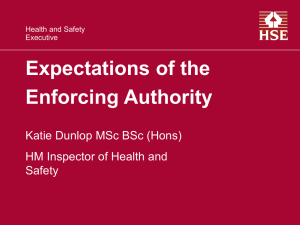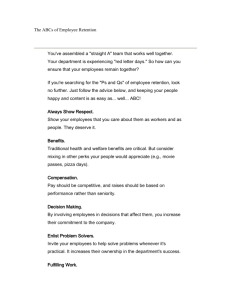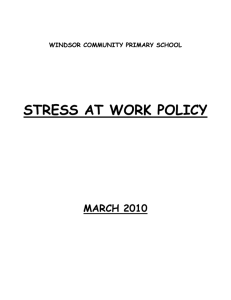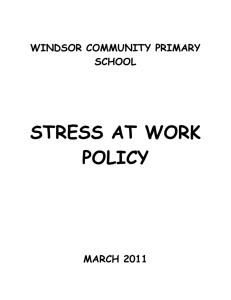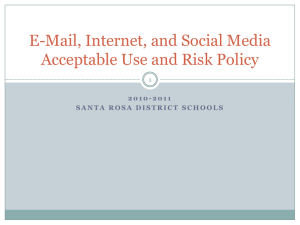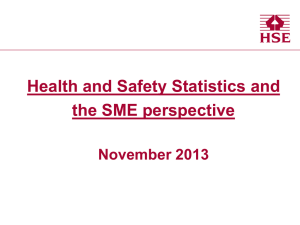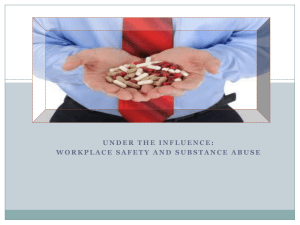SAN(G) 33 Managing the Causes of Work Related Stress in
advertisement
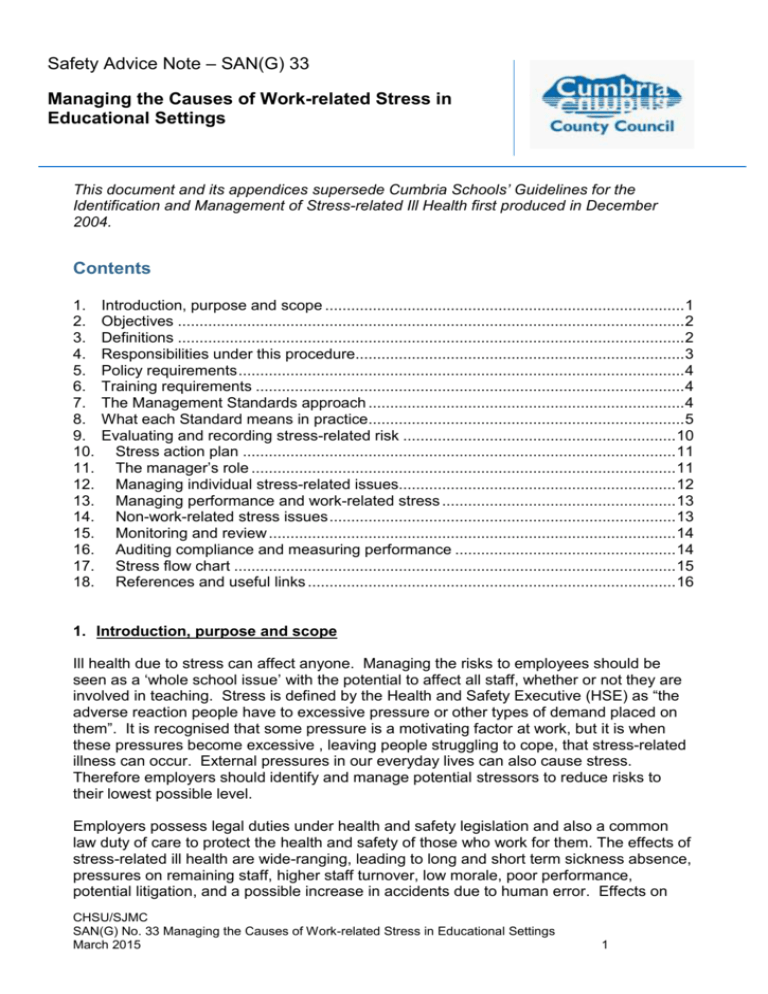
Safety Advice Note – SAN(G) 33 Managing the Causes of Work-related Stress in Educational Settings This document and its appendices supersede Cumbria Schools’ Guidelines for the Identification and Management of Stress-related Ill Health first produced in December 2004. Contents 1. 2. 3. 4. 5. 6. 7. 8. 9. 10. 11. 12. 13. 14. 15. 16. 17. 18. Introduction, purpose and scope ................................................................................... 1 Objectives ..................................................................................................................... 2 Definitions ..................................................................................................................... 2 Responsibilities under this procedure............................................................................ 3 Policy requirements ....................................................................................................... 4 Training requirements ................................................................................................... 4 The Management Standards approach ......................................................................... 4 What each Standard means in practice......................................................................... 5 Evaluating and recording stress-related risk ............................................................... 10 Stress action plan .................................................................................................... 11 The manager’s role .................................................................................................. 11 Managing individual stress-related issues................................................................ 12 Managing performance and work-related stress ...................................................... 13 Non-work-related stress issues ................................................................................ 13 Monitoring and review .............................................................................................. 14 Auditing compliance and measuring performance ................................................... 14 Stress flow chart ...................................................................................................... 15 References and useful links ..................................................................................... 16 1. Introduction, purpose and scope Ill health due to stress can affect anyone. Managing the risks to employees should be seen as a ‘whole school issue’ with the potential to affect all staff, whether or not they are involved in teaching. Stress is defined by the Health and Safety Executive (HSE) as “the adverse reaction people have to excessive pressure or other types of demand placed on them”. It is recognised that some pressure is a motivating factor at work, but it is when these pressures become excessive , leaving people struggling to cope, that stress-related illness can occur. External pressures in our everyday lives can also cause stress. Therefore employers should identify and manage potential stressors to reduce risks to their lowest possible level. Employers possess legal duties under health and safety legislation and also a common law duty of care to protect the health and safety of those who work for them. The effects of stress-related ill health are wide-ranging, leading to long and short term sickness absence, pressures on remaining staff, higher staff turnover, low morale, poor performance, potential litigation, and a possible increase in accidents due to human error. Effects on CHSU/SJMC SAN(G) No. 33 Managing the Causes of Work-related Stress in Educational Settings March 2015 1 individuals include both physical and psychological effects such as anxiety, depression, social withdrawal, poor concentration, insomnia, low self-esteem, increased dependency on drugs or alcohol, and deteriorating personal relationships. The Local Authority, governors and headteachers all have a key role to play in managing the causes of work-related stress in schools. The wider school community also has a responsibility to ensure people work safely and consider the safety of others. The purpose of this document is to provide guidance for schools which supports the County Council’s overall procedure for identifying, managing and minimising the possible causes of work-related stress. Although this procedure is applicable to all community and voluntary controlled schools, the principles will apply to other types of schools and can be adopted where there are separate employer arrangements in place, e.g. within voluntary aided, foundation and academy schools should they choose to do so. This document is also applicable to agency and interim workers working within schools, volunteers and any other persons who might be affected by the hazards that that this procedure is designed to protect against. The procedure has been developed to support national guidance and also the aims of teaching and non-teaching unions such as NUT, NASUWT, Unison and GMB. Further assistance and advice to help implement stress-management procedures should be sought where required. This can be accessed via the Corporate Health and Safety Team, HR providers and through your own Occupational Health service. 2. Objectives The objectives of this procedure are; a) to minimise the risks to our employees and others, and prevent them from suffering the effects of work-related stress, b) to ensure a focus on ‘whole school’ level solutions, c) to outline the procedures for identifying potential stress risk factors in school, d) to outline the provision and resources available to identify and deal with individual issues, e) to ensure that headteachers and staff can access the necessary information and training to effectively manage and identify stress, f) to set out any training requirements, g) to outline the overall approach for managing the causes of work-related stress, h) to set out arrangements for undertaking risk assessment, i) to set out the management requirements which are key to reducing and tackling stress-related issues, j) to set out the arrangements for addressing individual issues. 3. Definitions Health and safety practitioner A health and safety practitioner is a person holding the relevant health and safety qualifications appointed by Cumbria County Council to a specific health and safety position, typically undertaking an audit and/or advisory role. Examples of job titles in CHSU/SJMC SAN(G) No. 33 Managing the Causes of Work-related Stress in Educational Settings March 2015 2 Cumbria County Council that are covered by this definition include Health, Safety and Wellbeing Managers/Advisers/Assistant Advisers. In schools, a named lead health and safety practitioner will advise and help manage health and safety together with the support of advisers in the wider Corporate Health and Safety Team. HSE The Health and Safety Executive is responsible for the enforcement of health and safety legislation in all council-controlled premises. 4. Responsibilities under this procedure Local Authority As the employer of staff in community and voluntary controlled schools, the Local Authority has direct responsibilities under health and safety legislation. It also recognises its wider responsibility in assisting in the achievement of high standards in schools, and acknowledges that high levels of stress amongst staff can affect those standards. Duties to implement suitable systems and controls are delegated to governing bodies but the Authority retains its overall duties under relevant legislation. To support schools in achieving the aims of this procedure, the Authority will provide support, advice, guidance and training via the Corporate Health and Safety Team. Governing bodies Governing bodies have overall responsibility at a strategic level for implementing this procedure in their respective schools, and for ensuring there are local procedures in place where specific risks exist. They act as a ‘critical friend’ to the headteacher and as such should aim to ensure that both headteachers and staff can develop a reasonable balance between work and home life. They should also support the work of the headteacher in helping to reduce potential areas of stressrelated ill health. Headteachers Headteachers have overall responsibility for implementing this procedure on a dayto-day basis in their respective schools. Health and safety practitioners Health and safety practitioners are responsible for providing advice on health and safety matters related to work-related stress, in particular in relation to risk assessment requirements. Human Resources providers, school business managers and staff organising learning and development activities These people help monitor the effectiveness of measures to address stress by collating sickness absence statistics. Advise headteachers and staff on relevant HR policy and training requirements. CHSU/SJMC SAN(G) No. 33 Managing the Causes of Work-related Stress in Educational Settings March 2015 3 Provide continuing support to headteachers and individuals in a changing environment, and encourage referral to occupational health where appropriate. Heads of Department Heads of department implement appropriate controls for managing the causes of work-related stress within their areas of jurisdiction. All employees All employees have the responsibility to raise issues of concern with their immediate line managers or safety representatives. Notify to their manager the existence of unacceptable levels of stress as soon as possible. Attend Occupational Health referrals and accept counselling opportunities when recommended. Agency staff, interim appointees and volunteers The people identified in this section have a responsibility to cooperate with the school’s health and safety policy, safety procedures and local arrangements and rules. 5. Policy requirements Rather than have a separate Stress Policy, the Local Authority recommends that a short statement be included within the arrangements section of the school’s Health and Safety Policy. This has been incorporated into the Cumbria County Council’s model health and safety policy for schools. 6. Training requirements Periodically the Local Authority runs initiatives to promote stress awareness to its workforce. This includes subsidising the Headspace initiative for headteachers and promotion of the Worklife Support programme delivered by educational charity, Worklife Support: http://worklifesupport.com It is recommended that all employees receive personal development and relevant training to support them in performing their jobs. This in turn helps to prevent stress. Stress awareness training is recommended for headteachers and for all other staff. The Local Authority is currently developing training modules for its workforce, and the HSE also provides stress resources and tools which are free to access at: http://www.hse.gov.uk/stress/standards/downloads.htm 7. The Management Standards approach Cumbria County Council endorses the use of the HSE Management Standards. They were first introduced in 2004 and cover the six key areas recognised as having the potential to cause work-related stress. In other words, the six Management Standards cover the primary sources of stress at work. These are: CHSU/SJMC SAN(G) No. 33 Managing the Causes of Work-related Stress in Educational Settings March 2015 4 the demands of the job, the control people have over their work, the support received at work, i.e. from managers/colleagues, relationships at work, a person’s role in the organisation, change and how it is managed. The HSE Management Standards represent a set of conditions that, if present, reflect a high level of health, wellbeing and organisational performance. The HSE has called them the “Management Standards” because good management practices are key to achieving a positive workplace culture and in reducing the risks of work-related stress. Each Standard contains simple statements about good management practice for the six stressors, and they form a useful guide for carrying out your organisational stress risk assessment. They also act as a ‘benchmark’ for schools to assess how they are performing in relation to the Standards, and to assist in determining targets for improvement and action plans. The HSE recommends that all employers take a risk assessment-based approach, firstly at an organisational level. Like all risk assessments, this involves identifying the areas that can cause stress, determining the likely level of risk to health, identifying who might be harmed, and identifying the existing and additional control measures needed to ensure risks are reduced. Some larger schools choose to ask staff to complete anonymous survey questionnaires to gather information for the risk assessment process, but this might not be appropriate for smaller schools as staff may feel they are more easily identifiable. A model survey questionnaire is available for schools should they wish to follow this method. A model ‘whole school’ stress risk assessment and action plan has been provided by the Corporate Health and Safety Team following HSE guidance. This can be adapted and tailored to suit each school’s own approach. See section 9 of this document – Evaluating and recording stress-related risk. Other supporting documents, including an individual stress questionnaire, model stress survey questionnaire, symptom checker, and information for staff and school managers to help discuss and identify stress issues, can all be accessed via the Health and Safety section of the Schools’ Portal. See section 18 of this document – References and useful links. 8. What each Standard means in practice Demands All employees should be able to cope with the demands of their job. Headteachers should therefore provide their staff with achievable demands in relation to their hours of work. Job descriptions should be up-to-date and must clearly outline roles and responsibilities. Areas of concern are often: Workload - ensure that workloads are manageable, i.e. the number of different tasks, the complexity and intensity of the workload including emotional demands, deadlines and targets. CHSU/SJMC SAN(G) No. 33 Managing the Causes of Work-related Stress in Educational Settings March 2015 5 Deadlines/targets - how clearly are these understood, and is achievement well managed? The demands of working with others. Working patterns, including long working hours, working over contracted hours, working at home to complete work-related tasks, multi-site and off-site working, and travelling time. Support and help available from management and colleagues. The physical working environment, e.g. dealing with violence, abusive behaviour and lone working. Potential control measures - Demands Effective policies and procedures, e.g. Health and Safety Policy, violence at work and lone working procedures. Prioritisation and agreement of workload and tasks for particular jobs. Redistribution of workload/tasks where required. Realistic approach in relation to targets and deadlines. Agreed working patterns – e.g. working hours, flexible working measures, travelling time. Clear job descriptions. Adequate/additional resources and support to carry out the job. Good communication - participation in the decision-making processes – one-toones, team meetings. Support, listening, understanding and appreciation or thanks where required. Work/life balance initiatives, regular breaks encouraged. Safe working practices in place. Action plans developed where required. Control All staff should be satisfied that they are able to have a say about the way they do their work, and systems should be in place to address issues. Areas of concern are often: Staff have little input or opportunity to participate in how work is organised or carried out. Staff feel they are not involved in decision-making processes. The pace of work is being driven by external sources, leaving them feeling pressured and unable to cope. They have no control over the resources to do their jobs. There is a lack of support when undertaking new tasks. Their reported concerns are not listened to. Potential control measures - Control Set realistic deadlines/targets. Increase staff participation and empowerment in decision-making processes. Encourage two-way consultation and communication strategies, allow staff to air their views, and be prepared to change approaches where required. Delegation of tasks to avoid staff feeling things are getting ‘out of control’. Allocation of resources and support for curriculum changes/changes in role etc. Encourage CPD, staff development, new skills and training. Encourage mentoring and coaching. CHSU/SJMC SAN(G) No. 33 Managing the Causes of Work-related Stress in Educational Settings March 2015 6 Manage performance in a positive way. Work/life balance initiatives. Provision of stress-awareness information and training. Safe working practices. Support Management support refers to a range of formal and informal activities undertaken by management that support the work of staff. This should ensure that they receive adequate information and support, and that systems are in place to respond to individual concerns. The following factors are indicators of work-related stress with regard to the support: Lack of career-development and promotion routes. Few or no training opportunities. An over-competitive culture. Staff feel undervalued and unappreciated. Staff are given responsibility without the authority to take decisions. A blame culture. Poor communication throughout the institution. Lack of consultation with staff. Lack of respect for staff. Potential control measures - Support Management and colleagues are accessible. An ‘open door’ policy is encouraged, and effective time allocated for consultation and communication. Ensure induction procedure and staff handbooks contain information on support routes. Promote support available from external sources, e.g. GP, HR, Health and Safety Team and unions. Plan ‘observations’ with at least one week’s notice. Management show concern and empathy for those they manage. Staff are consulted and participate in decision-making processes. Ensure that performance management or capability procedures offer support where required. Individuals are supported at times of need, e.g. sick leave, external pressures. Provision of information and training for staff, and career development strategies in place. Ensure good feedback, praise and acknowledgement. Work/life balance initiatives. Safe working practices/procedures. Relationships This Standard describes the way we interact with other people at work. It ensures that employers promote positive working to avoid conflict, and that staff are not subjected to unacceptable behaviours, e.g. bullying at work or stress due to the potential for conflict with others. Relationships with managers, peers and others can dramatically affect the way all staff feel at the end of the working day. Systems need to be in place to reduce risks and respond to individual concerns. CHSU/SJMC SAN(G) No. 33 Managing the Causes of Work-related Stress in Educational Settings March 2015 7 The following factors should be considered: Unfair treatment by managers and decision-makers. Harassment of certain categories of staff, e.g. on the grounds of sex, race, and/or disability. Bullying, intimidation or other victimisation from managers, other staff and pupils/students. Dealing with heavy emotional demands. Lack of line-management support. Isolation in separate sections, e.g. no forum for staff to discuss common issues and problems. Poor communication in the organisation – both vertical and horizontal. Lack of social space/rest facilities in the workplace. Potential control measures - Relationships Headteachers should be fully supported by governors and leadership teams to implement relevant policies, e.g. Behaviour Policy, Discipline, and Performance Management. All staff know how to access and are aware of the requirements of behaviour, discipline, bullying and harassment procedures. A ‘zero tolerance’ approach is adopted for unacceptable behaviour, with staff encouraged to set a good example, e.g. managing emotions, staying calm, and admitting mistakes. Staff are encouraged to report all violent incidents. Support is offered and appropriate management action taken. Complaints procedure – complaints are treated seriously and acted on swiftly. External advice and support sought where required. Equal opportunities policy. Better ‘two way’ consultation and communication systems. Safe working practices adopted, conflict management training sought where required. Staff development and professional development opportunities. Role This Standard considers an individual’s role in the organisation, to ensure they understand their role and responsibilities. Roles should be clearly defined and understood to prevent ambiguity, and expectations placed on them should not conflict. There are two potentially stressful areas associated with a person’s role in an organisation. These are role conflict and role ambiguity: Role conflict – this exists when a person is torn between conflicting job demands, or by having to complete tasks that the person does not believe are part of their job. Examples of this would include: Job responsibilities heavy and demanding. Overly target/deadline driven culture. CHSU/SJMC SAN(G) No. 33 Managing the Causes of Work-related Stress in Educational Settings March 2015 8 Role ambiguity – this is where a person does not have a clear picture of their work objectives, often as a result of their responsibilities changing without being incorporated into their job description. Examples of this would include: Lack of clarity about role. Unclear job description. Job changes without consultation. Feeling undervalued by the institution. Organisational change without consultation. Potential control measures - Role Good communication and consultation mechanisms in place. Clear, up-to-date job descriptions. Clear work objectives and expectations. The school handbook should explain clearly the roles of all staff. Contingency plans in place to cover those times when teachers or staff with dual roles find themselves called upon to fulfil different aspects of their role at the same time. For example, emergency calls for the Head of Year/First Aider/Fire Safety Co-ordinator. Ensure that deadlines and targets set are achievable. Improved consultation measures. Measures to value the staff’s contribution. Change This Standard considers how staff are involved and considered during times of change. Change can include restructuring and reorganisation, redundancies, new initiatives and changes in leadership. Measures should be in place to ensure staff are consulted and can raise concerns. Factors that should be considered include: The pace and intensity of change. Any new educational initiatives that staff have to deal with. The provision of resources and time to manage new initiatives and change. Changes in leadership. Failure to consult over changes. Job insecurity experienced as a result of restructuring, redundancies, mergers etc. The impact of restructuring on workload and job responsibilities. Mergers of schools. The relocation of jobs. Restructuring and rationalisation measures. Cuts in resources. Perception or fear of future change. Potential control measures - Change Recruitment and HR Policies and procedures followed and adhered to. Staff consulted and involved in the planning process before change. Staff development sessions on new educational initiatives. CHSU/SJMC SAN(G) No. 33 Managing the Causes of Work-related Stress in Educational Settings March 2015 9 The allocation of sufficient time and resources for staff engaged in new initiatives. Consultation about changes ‘in good time’ with staff and with the recognised unions. Staff development needs analysed and acted upon. Consultation about how jobs/roles may change as the result of reorganisation or restructuring. Measures to ensure that work/life balance can be maintained and workloads do not increase as a result of change. Communication about new developments/change. Summary of HSE Management Standards Individuals are more willing to admit that they are suffering from stress if they can expect to be dealt with sympathetically. In some cases, access to good counselling might be all that is needed. Managers and supervisors should feel confident that they have sufficient information and training to help individuals cope with stress and to recognise when expert advice or help may be needed. If the principles of the HSE’s Management Standards are followed, all staff should be able to say that they: Feel that the demands placed upon them fall well within their capabilities. Are able to exercise some form of control over their work and the way they do it. Are aware of the support that is available to them from colleagues and management. Feel comfortable in their relationships with work colleagues and are not subject to unacceptable behaviours. Understand their role within the school. Are consulted and involved during times of change. If they are satisfied with these six factors, they are less likely to experience mental health problems. 9. Evaluating and recording stress-related risk As discussed earlier in this document, the recommended approach is for schools to develop an organisational level stress risk assessment which addresses each of the standards and details. The process of undertaking a risk assessment is the same as for other types of hazards and schools should follow the methodology outlined in Safety Advice Note SAN(G) 09 - Risk Assessment in Educational Establishments. The Local Authority Corporate Health and Safety Team has developed a model stress risk assessment for schools and model stress action plan, both of which can be adapted and tailored to suit each establishment. They can be downloaded from the Schools’ Portal. See section 18 of this document – References and useful links. In developing your whole school risk assessment you focus on issues that affect the whole school community. The process should be led by someone who has a good knowledge of the process of risk assessment, and should include all persons who have knowledge of the work of the school and who may assist in highlighting issues and suggesting appropriate controls. This also helps you to meet the Standards in ensuring that good consultation CHSU/SJMC SAN(G) No. 33 Managing the Causes of Work-related Stress in Educational Settings March 2015 10 and two-way communication exists to reduce work-related stress, as being involved at an early stage enables staff to have their say. Where an individual raises personal concerns or is returning to work following a stress absence then the individual stress questionnaire should be used to highlight areas of concern and agree suitable actions and control measures. This is usually completed by the employee in discussion with their line manager. See section 10 of this document – Stress Action Plan. 10. Stress action plan Following your risk assessment, there might be certain actions or improvements required. Schools can then develop a specific stress action plan. Again, a model has been prepared by the Corporate Health and Safety Team. You can also choose to include any longer term, identified, required actions in your school’s Health and Safety Management Plan. Each stress action plan requires schools to list the current position, planned solutions, who is responsible, and an idea of how actions will be taken forward and fed back to staff. 11. The manager’s role In schools, governing bodies, headteachers, heads of department and line managers have a pivotal role in helping to reduce the causes of work-related stress. They should ensure they utilise the controls which are available to them, most of which will be identified in your school’s stress risk assessment. They should: Undertake a whole school stress risk assessment and ensure, as far as possible, that they implement any controls identified and develop a stress action plan. Involve staff in the process and communicate the findings of the risk assessment and any stress action plan. Encourage staff members to report concerns and to participate in any surveys and groups that relate to work-related stress. Monitor the effectiveness of any actions that are implemented, making any adjustments that seem appropriate. Ensure good feedback to any groups that are established to address stress issues. Hold regular team meetings, staff appraisals and one-to-ones, so that wellbeing issues can be raised and addressed, ideally before they become a problem. Encourage open discussion, both formally and informally with governors, managers, colleagues, HR staff, Local Authority officers and trade union representatives. Encourage mentoring and support from other colleagues or managers. Keep up-to-date with the policies that the council has in place for addressing staff issues. Be familiar with the resources available via the Schools’ Portal and HSE website. Take an active part in any stress-related training and encourage staff to do the same. Demonstrate the behaviours expected by the Council and consider reviewing competence in relation to the Management Standards, using the HSE’s manager competence tool which is free to access at: (http://www.hse.gov.uk/stress/standards/downloads.htm) CHSU/SJMC SAN(G) No. 33 Managing the Causes of Work-related Stress in Educational Settings March 2015 11 Understand the personalities and interactions of team members and how these are relevant to potentially stressful situations. Show a positive attitude to stress and mental health issues. Demonstrate awareness, recognition and early identification of possible problems so that intervention at an individual level can take place as soon as possible. Show that they know how to approach issues sensitively. 12. Managing individual stress-related issues The main focus of your school’s stress risk assessment is on issues that are likely to be potential sources of stress for groups of staff. However, you also have a duty of care to protect the health and wellbeing of individuals, and there will be cases where individual concerns need to be addressed. Where an individual member of staff reports any work-related stress absence, is returning to work following a stress absence, or indicates that they are experiencing difficulties coping with excessive pressure at work, action should be taken immediately. An individual stress questionnaire should be completed by the individual and discussed with their headteacher or direct line manager (where possible). In instances where an employee does not wish to discuss issues with them, referral should be made to an appropriate HR advisor or other nominated senior staff member. (Copies of the questionnaire are available to download from the Schools’ Portal). The emphasis of any discussion between the employee and their manager should be to try and identify and alleviate, where possible, any work-based issues that may be contributing to the employee’s feeling of stress. It should be noted that individual stress questionnaire is not intended to be a replacement for the general return to work procedures which must also be followed. Headteachers/managers must ensure that they complete a referral to Occupational Health for any member of staff reporting a stress at work issue. Timely support and counselling, where required, can be then be put in place to help minimise any risks to the individual’s health. This is important for any staff who might have an underlying medical condition, especially if it is recognised under the Equality Act 2010. There are some conditions that employers have to make reasonable adjustments for. Where an employee is absent from work, it is important that the reason is accurately recorded, including whether the absence is work-related. This will help to build an accurate picture of absence that may help inform future actions. Employees should be advised of the availability of support, e.g. Occupational Health, counselling, employee representatives, GP. Employees should also be advised of the information and resources available to them on the intranet related to stress issues, e.g. NHS Choices. See section 18 of this document – References and useful links. CHSU/SJMC SAN(G) No. 33 Managing the Causes of Work-related Stress in Educational Settings March 2015 12 Action in cases of headteachers reporting work-related stress As with other staff, headteachers might display evidence of work-related stress. Headteachers who recognise that they are stressed should initially seek support from their Chair of Governors. Where the headteacher and/or Chair of Governors feels that further support from the LA is appropriate, the General Advisor should be informed. Where the headteacher/Chair of Governors does not wish to take this action initially, then the Local Authority’s Lead Health and Safety Advisor (Schools and Children’s Services) may be contacted to discuss an appropriate way forward. If staff in the school have reason to believe the headteacher is stressed, they should report this to the deputy/senior teacher. Should the deputy/senior teacher feel there are sufficient grounds for concern, he/she should discuss the situation with the headteacher in the first instance. Subsequently, if the concerns continue and the situation is not improving, the deputy/senior teacher should contact the Chair of Governors. The General Advisor or Lead Health and Safety Advisor (Schools and Children’s Services will consider with the school any action and/or support necessary, and will as appropriate, instigate the necessary action in line with the spirit of these procedures. 13. Managing performance and work-related stress The aim of managing performance is key to improving both the performance of individuals and that of the school. It involves making sure that the performance of employees contributes to the aims of the school as a whole. It is important that employees recognise that this is an important and required part of their working life. The performance of all employees should be managed from induction and through appraisal and regular formal and informal meetings and discussions. Employees should monitor that the required meetings are taking place and remind their managers where necessary if they are not. If performance management is communicated badly or managed poorly, it can itself place excessive pressures on an individual, resulting in a breakdown in working relationships which could lead to workrelated stress absence. 14. Non-work-related stress issues Although non-work-related stress, e.g. home-related stress due to family ill health, financial pressures or relationships, is beyond the scope of HSE guidance, it is still important to recognise that external influences can impact on an individual’s performance at work. They can choose not to share their concerns with you, and in these cases their wishes should be respected. In these cases, signposting employees to other sources of help and support can be advantageous. You may be able to suggest other people they could speak to, such as a trade union representative, an HR officer, an occupational health professional, an adviser from a support agency, or a colleague or friend. If they are able to share their concerns with you, just try to listen and see if you can help. You might be able to make adjustments to the person’s working life in the short term so that they can spend more time resolving CHSU/SJMC SAN(G) No. 33 Managing the Causes of Work-related Stress in Educational Settings March 2015 13 personal issues. If you do make adjustments, avoid overloading other members of the team or yourself. 15. Monitoring and review The school risk assessment and action plan should be regularly reviewed. This may be at periods determined as suitable by the governing body. In the case of individuals, there should be a full review of progress at the end of an agreed period, not normally more than six weeks. (Where the member of staff has been absent, this will be an agreed period following the full-time return to work). The review meeting should consider whether actions taken have been helpful. Further action might be necessary and will vary depending on the circumstances of the case. It may include, for example, further meetings, further training or support, a change of duties where feasible, a review of the organisation and management of the school, advice from Occupational Health, or a request for another referral to Occupational Health. Medical advice may be received to the effect that the employee should not return to his or her present job. In these circumstances, the employee should be advised of the implications of the medical advice and possible options. 16. Auditing compliance and measuring performance Compliance with safety procedures in community and voluntary controlled schools will be audited by the Corporate Health and Safety Team as part of their 3-year rolling audit programme. Where there is reason to believe that levels of work-related stress in a school might be excessive, the matter will be raised with the headteacher. Should there be no improvement, the governing body may be approached and asked to implement measures to address the situation. Local review and monitoring of risk assessment and controls should be implemented at regular intervals (usually annually) as deemed appropriate by the governing body and headteacher. CHSU/SJMC SAN(G) No. 33 Managing the Causes of Work-related Stress in Educational Settings March 2015 14 17. Stress flow chart The flow chart below outlines the steps to be taken by governing bodies/headteachers/heads of department in relation to managing work-related stress: CHSU/SJMC SAN(G) No. 33 Managing the Causes of Work-related Stress in Educational Settings March 2015 15 18. References and useful links Supporting documents to this procedure are available via the Schools’ Portal: Reference Library (All Documents) – Health and Safety – Wellbeing in Schools They include Model stress risk assessment for schools Model stress action plan Individual stress risk assessment questionnaire HSG218. Managing the causes of work-related stress. A step-by-step approach using the Management Standards. HSE 2007.http://www.hse.gov.uk/pubns/priced/hsg245.pdf Cumbria County Council Safety Procedure No 20 – Managing the Causes of Work-related Stress School’s own Health and Safety Policy, Section 2 – Arrangements – Work-related Stress Useful websites: HSE – Stress internet site: http://www.hse.gov.uk/stress/ NHS Choices – Work-related Stress resources: http://www.nhs.uk/conditions/stress-anxietydepression/pages/workplace-stress.aspx NHS Choices Main Site http://www.nhs.uk/Pages/HomePage.aspx CHSU/SJMC SAN(G) No. 33 Managing the Causes of Work-related Stress in Educational Settings March 2015 16
